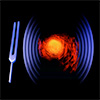| Feb 06, 2025 |
|
|
|
(Nanowerk News) Scientists at Goethe University Frankfurt have identified a new way to probe the interior of neutron stars using gravitational waves from their collisions. By analyzing the “long ringdown” phase – a pure-tone signal emitted by the post-merger remnant – they have found a strong correlation between the signal’s properties and the equation of state of neutron-star matter.
|
|
The results were recently published in Nature Communications (“Constraining the equation of state in neutron-star cores via the long-ringdown signal”).
|
 |
| The signal emitted by two merging neutron stars resembles that of a tuning fork. (Image: L. Rezzolla/pixabay)
|
|
Neutron stars, with a mass greater than that of the entire solar system confined within a nearly perfect sphere just a dozen kilometers in diameter, are among the most fascinating astrophysical objects known to humankind. Yet, the extreme conditions in their interiors make their composition and structure highly uncertain.
|
|
The collision of two neutron stars, such as the one observed in 2017, provides a unique opportunity to uncover these mysteries. As binary neutron stars inspiral for millions of years, they emit gravitational waves, but the most intense emission occurs at and just milliseconds after the moment of merging. The post-merger remnant – a massive, rapidly rotating object formed by the collision – emits gravitational waves in a strong but narrow frequency range. This signal holds crucial information about the so-called “equation of state” of nuclear matter, which describes how matter behaves at extreme densities and pressures.
|
|
Prof. Luciano Rezzolla’s group at Goethe University Frankfurt now discovered that although the amplitude of the post-merger gravitational-wave signal diminishes over time, it becomes increasingly “pure”—tending toward a single frequency, much like a giant tuning fork resonating after being struck. They have termed this phase the “long ringdown” and identified a strong connection between its unique characteristics and the properties of the densest regions in neutron-star cores.
|
|
“Just like tuning forks of different material will have different pure tones, remnants described by different equations of state will ring down at different frequencies. The detection of this signal thus has the potential to reveal what neutron stars are made of,” says Rezzolla, adding, “I am particularly proud of this work as it constitutes exemplary evidence of the excellence of Frankfurt- and Darmstadt-based scientists in the study of neutron stars, which have been a central focus of the Hessian research cluster ELEMENTS.”
|
|
Using advanced general-relativistic simulations of merging neutron stars with carefully constructed equations of state, the researchers demonstrated that analyzing the long ringdown can significantly reduce uncertainties in the equation of state at very high densities – where no direct constraints are currently available. “Thanks to advances in statistical modeling and high-precision simulations on Germany’s most powerful supercomputers, we have discovered a new phase of the long ringdown in neutron star mergers,” says Dr. Christian Ecker, first author of the study, “It has the potential to provide new and stringent constraints on the state of matter in neutron stars. This finding paves the way for a better understanding of dense neutron star matter, especially as new events are observed in the future.”
|
|
Co-author Dr. Tyler Gorda adds: “By cleverly selecting a few equations of state, we were able to effectively simulate the results of a full statistical ensemble of matter models with considerably less effort. Not only does this result in less computer time and energy consumption, but it also gives us confidence that our results are robust and will be applicable to whatever equation of state actually occurs in nature.”
|
|
While current gravitational-wave detectors have not yet observed the post-merger signal, scientists are optimistic that the next-generation detectors, such as the Einstein Telescope expected to become operational in Europe within the next decade, will make this long-awaited detection possible. When that happens, the long ringdown will serve as a powerful tool to probe the enigmatic interiors of neutron stars and reveal the secrets of matter at its most extreme.
|


